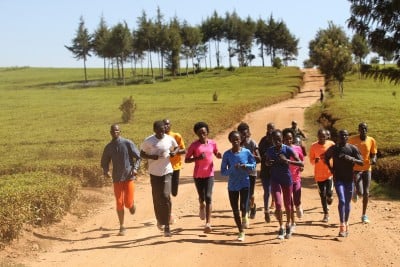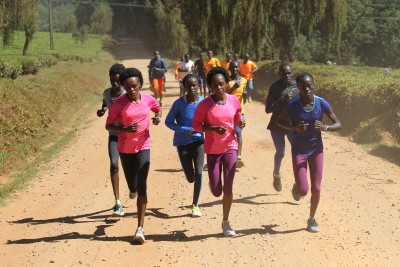My Trip to a Possible Doping Camp in Kenya: What I Saw When I Spent a Day with Olympic Champion Jemima Sumgong
by Weldon Johnson, LetsRun.com
April 20, 2017
“Myself, I am sure I am clean. No doping scandal at all (with me).”
Those were the last words Jemima Sumgong said to me at the press conference after the marathon at the Rio Olympics where Sumgong cemented her status as the number one women’s marathoner in the world by winning gold in 2:24:04.
Sumgong’s conviction in expressing she was clean in Rio, where she used the word “clean” seven times, was much stronger than when I had previously interacted with her, at the 2014 TCS New York City Marathon press conference when the news had just broken that her sometimes training partner Rita Jeptoo had tested positive for EPO. At that press conference, Sumgong stressed how little she trained with Jeptoo and acted very naive toward the concept of drugs being in Kenya. She went on to finish second in New York, but did not have her big breakthrough until winning London in April 2016 and following it up with a win at the Olympics.
After the Olympics, Sumgong’s training group established itself as the top female marathon group in the world as her training partner and sister-in-law, Sarah Chepchirchir, had a tremendous breakthrough of her own, running 2:19:47 to win the Tokyo Marathon in February. Chepchirchir’s brother is Noah Talam, who not only is Sumgong’s husband, but also the coach of Sumgong and Chepchirchir and the entire Rosa e Associati female training group that Sumgong is a part of.
 The sign outside Sumgong’s training camp (by Jean-Pierre Durand for the IAAF)
The sign outside Sumgong’s training camp (by Jean-Pierre Durand for the IAAF)
What explained the rise of Sumgong and Chepchirchir in the marathon ranks? I was not naive to the possibility of doping being the answer, but was there another explanation on how this group had ascended to the top of the running world?
Last month, I went with open eyes searching for that answer to the Nandi District in Kenya, above the Rift Valley, to observe Sumgong, Chepchirchir, and others in their training camp as part of the IAAF Day in the Life program.
A little more than a week after my return from Uganda and Kenya, it was announced that Jemima Sumgong’s “A” sample had tested positive for EPO. If the “B” sample confirms the result, Sumgong will be the most prominent Kenyan athlete to be banned from the sport for doping.
Did my visit to Sumgong’s camp raise my suspicions of possible doping in the group? No, it actually had the opposite effect. I left thinking they could be doing it clean.
On my visit to Nandi, I observed an easy run of little over an hour of Sumgong and her training mates. Afterwards, I had tea with them at a motel and went to their training house, where the other journalists and I interviewed Tokyo champ Chepchirchir, 2016 Olympian and Paris champ Visiline Jepkesho, and former World Youth champ Purity Rionoripo, who lowered her PB from 2:24:47 to 2:20:55 to win the Paris Marathon two weekends ago. Then we went to the house Sumgong and Talam are building, the house I perhaps prematurely referred to as the World Marathon Majors House, and spoke to Sumgong and Talam jointly. More details on the trip below.
(Editor’s note: Full 32-minute video of the talk with Sumgong and Talam here, 3 minutes of highlights with Sumgong here, Noah Talam talking for 4 minutes on Rita Jeptoo’s bust and why he is a good coach here. Chepchirchir full interview here, 2 minutes of highlights here where she explains why Kenyans have to be good at running. Purity Rionoripo here).
The Olympic Champ* Goes for an Easy Run
The run itself was uneventful. The Olympic champion just looked more fluid and faster on her easy run than most of you do on yours. The runners started really slow on the easy run and finished faster, with the women opening things up a bit the final minute. Many of you may not train like that but a lot of world-class runners do.
One thing really stood out to me. While this was a women’s training group, there were six women and nine men on the run.
The men’s primary job is to make the women world beaters. After the women’s goal races, some of the men go abroad and run their own races (one of the guys talked about running a 1:04 half marathon in China) hoping to make a few extra thousand dollars, but every day they are there training with the women, able to push them a little more than another female could.
If runners benefit from training with faster training partners, it’s a no-brainer that the top women in the world should train with men. Here was an entire group set up like this.
The Training Camp
After the run, the runners piled into the back of an overcrowded pickup truck and we drove to a motel to have Kenyan tea before going to their training camp.
The training camp has a metal fence at the entrance and a big sign featuring the Nike swoosh outside of it. Some of the runners live at the training camp, but not all, as Sumgong and her husband live nearby. The training camp is a place to live, eat, and hang out between runs. By Kenyan standards, this one was very nice, which meant it was well-built, but like most of rural Kenya, it was still pretty rudimentary by Western standards. They did have massage tables and some electrical stimulation machines, but nothing about the place screamed sophistication. At one point, my mind wandered to the thought of doping, and I thought either “they’re not doing it” or “it’s super easy to do and not get caught.”
The biggest difference in terms of technology between this visit and the one I took to Kenya 10 years ago was that a lot of today’s top runners, including both Sumgong and men’s Olympic champ Eliud Kipchoge (whom we visited at his camp the next day), wear Garmin watches so they can track their pace. Everything else I saw was the same simple training I saw a decade earlier, a ton of runners training on dirt roads and dirt tracks.
Sumgong Explains How She Became the Best in World
Sumgong had a simple answer on why she went from being a very good pro (2:20:48 for 2nd in Chicago in 2013, 3rd in Boston and 2nd in New York in 2014) to a world beater. She credited her change in form to her husband Noah Talam becoming her coach.
I didn’t ask her about her transformation as a runner pre- and post-2012. Through 2012 (when she turned 28 years old), she had run seven marathons, none faster than 2:28:32.
Sumgong didn’t have negative words for her previous coach, Italian Claudio Berardelli. She said Claudio’s training was hard, but the problem was that Claudio didn’t understand her as an athlete like her husband.
“[Noah] is more understanding than [Claudio]. I had more pressure under Claudio… [Noah] can understand me,” she said, noting that Noah knows when to back off in training and give her more time to improve. “It’s a big difference,” she said of the styles of the two coaches.
Noah agreed with Sumgong’s assessment.
“I really understand more my athletes. I know the pain of running. I am running with them too… so I can understand more… That is why everyone is doing really well,” he said. Noah, who used to be a pacer for the group and was a 2:15 marathoner himself, runs with the athletes on most of their easy runs.
Interestingly, Noah only became Sumgong’s coach in the aftermath of Rita Jeptoo testing positive for EPO — a development that was made public in October 2014. Jeptoo’s agents, the Rosas (father Gabriele and son Federico), and coach, Berardelli, were all getting heat from Kenyan authorities after Jeptoo’s positive test. It wasn’t feasible for Berardelli to remain as coach, and Talam gradually took over the coaching duties. Dr. Gabriele Rosa came out of mini-retirement to help Talam as well.
I asked Talam about the coaching switch, and he was clear in his answer that Berardelli was a victim and not responsible for Jeptoo’s doping.
“Claudio was victimized,” he said. “There were some athletes misled by local people. They went and did the wrong things. They ended up taking some drugs that aren’t allowed in athletics.”
The issue of doping became “rampant” in Kenya after Jeptoo’s positive test and “when [Claudio] was victimized, everyone was pointing, pointing, pointing, [and Claudio stepped down as coach],” Talam said.
When Talam’s sister, Chepchirchir, was asked about why people in Kenya dope, she made it sound like the ones who were looking for shortcuts doped.
“Some people like to run but they can not run [very fast]. It (running fast) is a talent,” she said.
The Kenyan Secret: “If we do not win, we do not get money. If we do not get money, how can we live?”
When Chepchirchir was asked about the “secret” of Kenya’s success in running, she answered that it was a lot of hard work, motivation and culture.
“I don’t do anything. I just run. So I have to just focus on running. We don’t have any other jobs. Where we get money, it is from running. That makes us to work hard. If we do not win, we do not get money. If we do not get money, how can we live? In Kenya, everything is money, money, money. So we have to make it [in running],” Chepchirchir said, noting she ran 3,000 km in the 3 months before the Tokyo Marathon, which comes out to about 20 miles a day.
The biggest surprise to me from Sumgong’s group was when I asked them what they thought of Paula Radcliffe‘s 2:15:25 world record. Both Chepchirchir and Talam thought it was attainable.
“If she (Jemima) is focused I don’t see anything (impossibly) hard (about the world record)… I can say it is possible if they train very well and they get very focused without any disturbances, with proper diet,” Talam said.
With her positive “A” sample, it’s no longer possible for Sumgong not to have any disturbances.
So far, the rest of the group has been able to put the disturbance of Sumgong’s positive test behind them. Less than a week after Sumgong’s positive test was announced, her training partner Purity Rionoripo won the Paris Marathon in 2:20:55, a personal best by nearly 4 minutes. When I asked Rionoripo what she thought she could run in Paris, she said at the time, “Maybe 2:21-2:22.”
She too was quick to credit her coach and her training partners.
“We train so hard. We do long runs, some speed work… We do it as teamwork. Our coach is very fantastic, very nice, very wonderful coach. He treats us as brothers and sisters.”
The story of a tight-knit training group with a coach related to two of the runners doesn’t look quite the same as it did last month when I was in Kenya.
*Sumgong may not be stripped of her Olympic title even if her positive test is upheld because her positive test was after the Olympics.
****
Addendum: When LetsRun.com’s Jonathan Gault read this piece he asked me how I felt when I heard about the EPO positive. I think mainly I felt stupid and a bit angry. Sumgong gets to have her “B” sample tested, but considering the history of her training partner, I think it will confirm the “A” result. If that’s the case, how could I be so dumb and really start to believe she was clean? When I asked Sumgong in New York in 2014 about Jeptoo’s positive test, she played the innocent, naive card about drugs. Then after we spoke, I found out Sumgong had tested positive for what I thought was prednisone, but turned out to be prednisolone, but did not get a drug conviction because she had a valid reason for the drug. (Prednisolone is a steroid that can be used for inflammation and is the drug Chris Froome was allowed to use in the Tour de France. Prednisone (slightly different spelling) is a corticosteroid that can turn into prednisolone in the liver and is what Galen Rupp takes for allergies). When I initially discovered in New York that Sumgong had had the positive test, I was pretty pissed off as I felt she had purposely misled me by pretending to not understand me or much of what I was asking. However, after some reflection I thought, “well the drug wasn’t that serious anyway”, she was cleared by authorities, and English isn’t her first language, so what I wrote about at the time was very tame. However, something just didn’t feel right.
I wasn’t naive to the idea she could be doping, so I asked her about it at Rio. Her strong words against doping were music to my ears. Then when I met with her in Kenya, of course I still had some doping questions, but personally wanted at the very least to hear a plausible story for the tremendous success of her group. I definitely got one. On top of it, Jemima and Noah were very friendly to us, so I was open to the possibility they were clean. What else could I do? I hadn’t started my story on them when the “A” positive test was announced, but had started thinking about it. And it was going to be along the lines of “here’s how the best women’s training group explains its success.” Essentially, the story above, but without the “A” sample positive test.
Fool me once shame on you, fool me twice shame on me, fool me three times… I feel stupid and angry. Don’t invite me into your house, if the whole thing is a fraud was one of my thoughts.
LRC note: Weldon Johnson is the co-founder of LetsRun.com. He somehow ran 28:06 for 10,000m to beat Abdi Abdirahman at USATFs in 2003. The IAAF Day in the Life Program arranged the visit to Sumgong’s camp and paid for the author’s transportation and accommodation within in Kenya. They had no input on this article.
***
Video Highlights of Sumgong and Her Group
7-Minute Video of Sumgong and Crew on an Easy Run at Nandi Tea Plantations in Kenya
Jemima Sumgong on Why She’s Better With Her Husband as Coach:
Noah Talam on His Skills as a Coach and Claudio Berardelli:
Sarah Chepchirchir on the Kenyan “Secret”:
(Editor’s note: In addition to the videos above the full 32-minute video of the talk with Sumgong and Talam is here, the Chepchirchir full interview is here, and a video with Purity Rionoripo here).
LRC note: The IAAF Day in the Life Program arranged the visit to Sumgong’s camp and paid for the author’s transportation and accommodation while in Kenya. They had no input on this article.
Sumgong’s Progression in Marathon From Tilastopaja.net
| 2006 2:35:12 | 1 | Las Vegas NV | |
| 2007 2:29:41 | 4 | Frankfurt | |
| 2008 2:30:18 | 2 | San Diego CA | |
| 2010 2:32:34 | 5 | San Diego CA | |
| 2011 2:28:32 | 1 | Castellón | |
| 2012 2:31:52 | 2 | Boston MA | |
| 2013 2:20:48 | 2 | Chicago IL | |
| 2014 2:20:41 | 3 | Boston MA | |
| 2015 2:24:23 | 6 | London | |
| 2016 2:22:58 | 1 | London |






